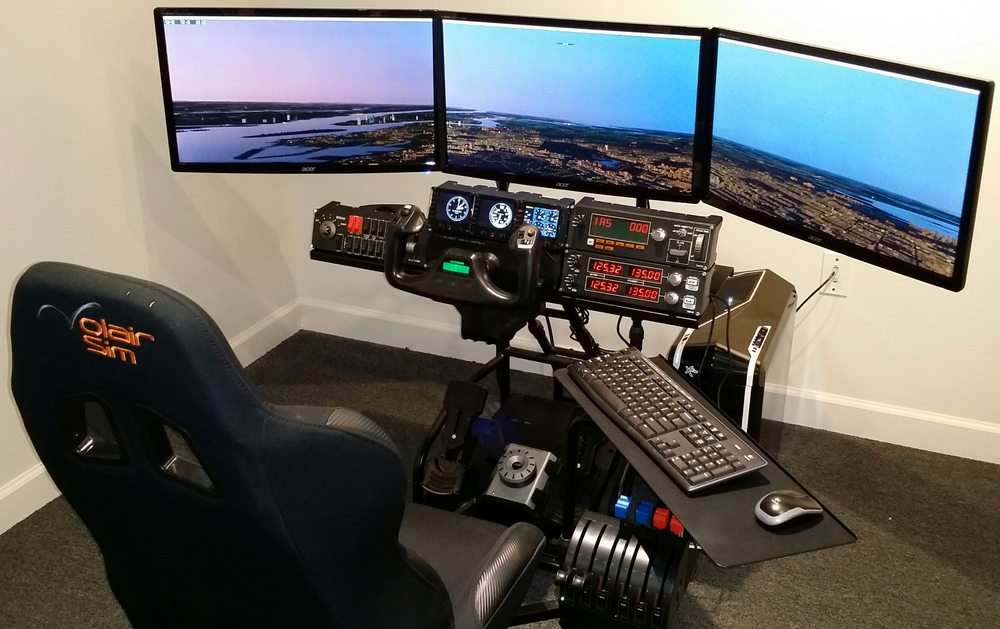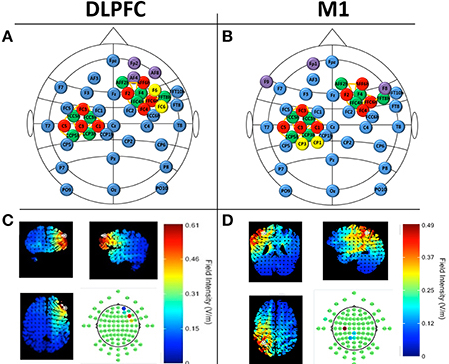Now you can learn to fly a plane from expert-pilot brainwave patterns
February 12, 2016

Elite X-Plane General Aviation Dream Package flight simulator system (credit: Xforce PC)
You can learn how to improve your novice pilot skills by having your brain zapped with recorded brain patterns of experienced pilots via transcranial direct current stimulation (tDCS), according to researchers at HRL Laboratories.
“We measured the brain activity patterns of six commercial and military pilots, and then transmitted these patterns into novice subjects as they learned to pilot an airplane in a realistic flight simulator,” says Matthew Phillips, PhD.
The study, published in an open-access paper in the February 2016 issue of the journal Frontiers in Human Neuroscience, found that novice pilots who received brain stimulation via electrode-embedded head caps improved their piloting abilities, with a 33 percent increase in skill consistency, compared to those who received sham stimulation. “We measured the average g-force of the plane during the simulated landing and compared it to control subjects who received a mock brain stimulation,” says Phillips.
“Pilot skill development requires a synthesis of multiple cognitive faculties, many of which are enhanced by tDCS and include dexterity, mental arithmetic, cognitive flexibility, visuo-spatial reasoning, and working memory,” the authors note.
Measuring brain activity to infer learning

Neuroimaging and tDCS experimental setup for stimulation. EEG locations are denoted in blue, fNIRS sources (red), and detectors (green). tDCS electrodes are denoted in purple (cathodes) and yellow (anodes). C and D: Predicted electric field intensities. (credit: Jaehoon Choe et al./Front. Hum. Neurosci.)
The study focused on a working-memory area — the right dorsolateral prefrontal cortex (DLPFC) — and the left motor cortex (M1), using continuous electroencephalography (EEG) to monitor midline frontal theta-band oscillatory brain activity and functional near infrared spectroscopy (fNIRS) to monitor blood oxygenation to infer neuronal activity.
The researchers used the XForce Dream Simulator package from X-Force PC and the X-plane 10 flight simulator software from Laminar Research for flight simulation training.
Previous research has demonstrated that tDCS can both help patients more quickly recover from a stroke and boost a healthy person’s creativity; HRL’s new study is one of the first to show that tDCS is effective in accelerating practical learning.
Phillips speculates that the potential to increase learning with brain stimulation may make this form of accelerated learning commonplace. “As we discover more about optimizing, personalizing, and adapting brain stimulation protocols, we’ll likely see these technologies become routine in training and classroom environments,” he says. “It’s possible that brain stimulation could be implemented for classes like drivers’ training, SAT prep, and language learning.”
HRL Laboratories, LLC | Enhanced Training Through Neurostimulation
Abstract of Transcranial Direct Current Stimulation Modulates Neuronal Activity and Learning in Pilot Training
Skill acquisition requires distributed learning both within (online) and across (offline) days to consolidate experiences into newly learned abilities. In particular, piloting an aircraft requires skills developed from extensive training and practice. Here, we tested the hypothesis that transcranial direct current stimulation (tDCS) can modulate neuronal function to improve skill learning and performance during flight simulator training of aircraft landing procedures. Thirty-two right-handed participants consented to participate in four consecutive daily sessions of flight simulation training and received sham or anodal high-definition-tDCS to the right dorsolateral prefrontal cortex (DLPFC) or left motor cortex (M1) in a randomized, double-blind experiment. Continuous electroencephalography (EEG) and functional near infrared spectroscopy (fNIRS) were collected during flight simulation, n-back working memory, and resting-state assessments. tDCS of the right DLPFC increased midline-frontal theta-band activity in flight and n-back working memory training, confirming tDCS-related modulation of brain processes involved in executive function. This modulation corresponded to a significantly different online and offline learning rates for working memory accuracy and decreased inter-subject behavioral variability in flight and n-back tasks in the DLPFC stimulation group. Additionally, tDCS of left M1 increased parietal alpha power during flight tasks and tDCS to the right DLPFC increased midline frontal theta-band power during n-back and flight tasks. These results demonstrate a modulation of group variance in skill acquisition through an increasing in learned skill consistency in cognitive and real-world tasks with tDCS. Further, tDCS performance improvements corresponded to changes in electrophysiological and blood-oxygenation activity of the DLPFC and motor cortices, providing a stronger link between modulated neuronal function and behavior.